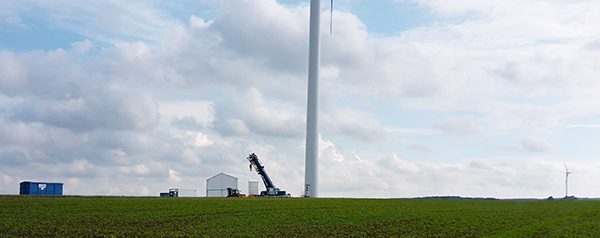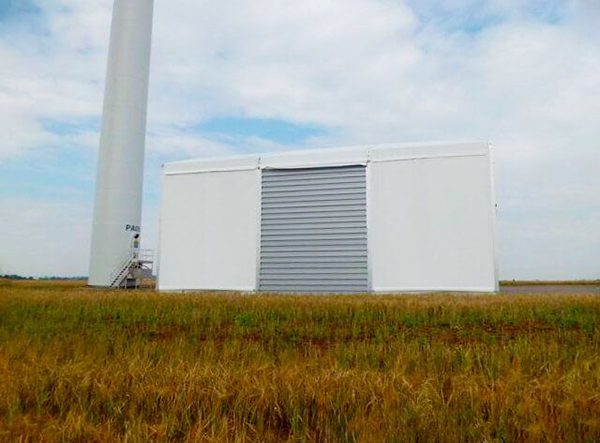by Laura Wilms
Wind is an inexpensive and clean raw material with an endless supply. The investment costs of wind turbine generators also pay for themselves quickly. But only if the generators run as smoothly as possible over their service life. High maintenance costs, on the other hand, quickly lead to higher operational costs and therefore reduced revenues for the turbine generator operators.
“Wind turbine generators must be a worthwhile investment, both from an ecological and an economic point of view,” says Mark Borkenhagen, Project Manager at Siemens Service Wind Power, the world’s leading manufacturer of wind turbine generators. “Advancements in rotor blade design and generator technology have already allowed us to continuously improve the efficiency of our wind turbine generators. However, in order to make wind power competitive versus conventional forms of power generation, every cent that we can save is crucial.”
To reduce repair costs, Siemens Service Wind Power hit on the idea of installing a temporary building for repairs on the actual wind farm sites. Key goal was to avoid the expensive and time-consuming transportation of heavy loads to workshops. Also, Siemens wanted to be able to use the new semi-permanent warehouse solution throughout Europe, i.e. it had to be possible to install and dismantle the building quickly to be able to rotate from wind farm to wind farm as required. The warehouse also had to be big enough to house the turbine parts as well as the repair equipment. Wind turbine generators boast dimensions that do not fit into any standard temporary building – what was required was a special solution.
Siemens chose Herchenbach Industrie-Zeltebau GmbH, a manufacturer of temporary buildings and semi-permanent warehouses made from aluminium, as the partner for this challenge. The result of this new project is a special Herchenbach Heba-Fix® temporary building, ten metres wide and 15 metres long, with an side height of 6.40 metres.

Temporary building
The main design challenge was the question of how to get the wind turbine parts into the building as they would not fit through the side walls of a temporary building. Herchenbach therefore developed a special temporary building solution, based on a corrosion-free premium quality aluminium frame, a high-quality PVC industrial-grade tarpaulin in the roof, trapezoidal sheet metal and tarpaulin walls. This allows the roof to be partially opened up, meaning that the parts to be repaired can be lowered into the building through the roof opening with the aid of a crane.
The frame and the components had to be planned and designed with particular precision for this purpose. “Even when the roof tarpaulin is temporarily removed, the structure has to remain stable in spite of high wind loads,” stresses Tobias Raeber, Managing Director of Herchenbach. “We therefore incorporated robust steel trapezoidal sheet metal walls and further reinforcements to provide additional stability, making the building withstand high loads.”
A further advantage of the Herchenbach temporary buildings is that they can be installed without any foundation on almost any surface. This is made possible by a special ground anchoring solution.
In addition, temporary buildings from Herchenbach are ideally suited to temporary use at different locations thanks to their modular design. “All components are bolted or fitted together, nothing is permanently welded,” Tobias Raeber explains. “The buildings can be quickly dismantled at any time and put up again at other locations.”
The temporary building supplied to Siemens Service Wind Power was installed for the first time – within 24 hours – in autumn 2015 in the Picardie region of northern France. After four repairs, it was put into storage until its next use in January 2016 in Tinglev, Denmark. “Here, too, the installation went smoothly,” says Mark Borkenhagen. “We have therefore achieved our objective of rotating the new temporary building around the various wind farms in Europe. And that really does work without too much time-consumption, and our costs are a fraction of what they were with the old method of transporting heavy loads,” Borkenhagen adds.
Laura Wilms is a freelance Journalist based in Cologne, Germany. She specialises in industry topics.
About Herchenbach
Herchenbach Industrie-Zeltebau GmbH was founded in 1924 and specialises in the manufacturing, sale and hire of temporary buildings, semi-permanent warehouses and steel structures for trade and industry. The company is based in Hennef (Germany) and employs around 130 staff. Its customers include over 1,000 companies worldwide. The company’s modular building systems are used for a wide range of applications. In Germany alone, more than 2,000 temporary building projects have been successfully completed to date.
www.herchenbach.co.uk
www.herchenbach.de
Press contact Herchenbach
Sebastian Glaser
möller pr
Tel.: +49 (0)221 801087-80
e-mail: sg@moeller-pr.de
URL: www.moeller-pr.de

Outside Frontal

Outside Side Wall
Scott Ellyson, CEO of East West Manufacturing, brings decades of global manufacturing and supply chain leadership to the conversation. In this episode, he shares practical insights on scaling operations, navigating complexity, and building resilient manufacturing networks in an increasingly connected world.